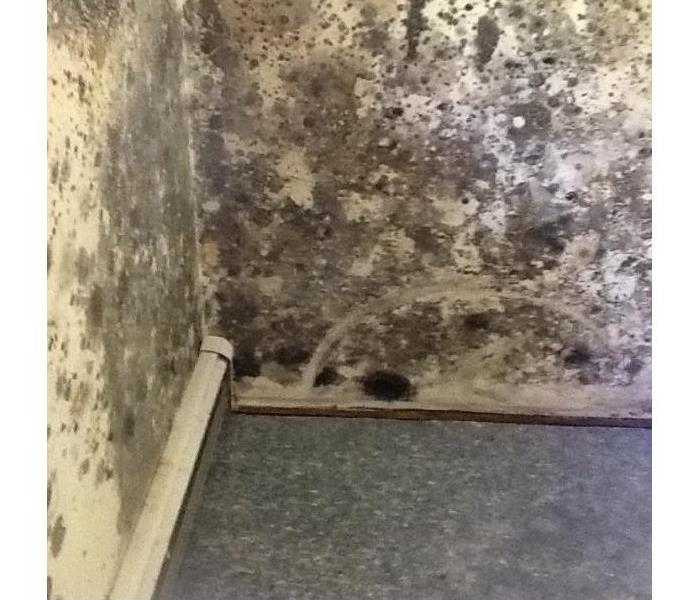Mold: Chapter 1 - Background
5/4/2017 (Permalink)
The subject of mold growth and remediation can be a complex issue which prompts many questions:
- How did the growth happen?
- Is my health in danger?
- How do I get rid of it?
- Will it happen again?
We'll issue a series of blogs to present the various points on mold growth and what you can do about it.
What is mold?
The term “mold” is a colloquial term for a group of filamentous fungi that are common on food or wet materials. This includes the green Penicillium species that produces penicillin, and fungi that spoil our bread, fruit, cheese and crops. Most of these are Ascomycetes (def: ascomycetes include most molds, mildews, and yeasts, the fungal component of most lichens, and a few large forms such as morels and truffles) that produce a lot of spores.
The majority of the molds that grow on damp building materials are found in the soil and are adapted to grow on a wide variety of materials. Outdoors, molds live in the soil, on plants, and on dead or decaying matter. There are thousands of species of mold and they can be any color. Different mold species are adapted to different moisture conditions ranging from very wet to just damp. Many times, mold can be detected by a musty odor. Live spores act like seeds, forming new mold growths (colonies) under the right conditions. All of us are exposed to a variety of fungal spores daily in the air we breathe, both outdoors and indoors.
How mold gets into a house or building
Mold and fungal spores occur naturally outdoors, where fungi are the earth’s most important recyclers. Indoors, mold needs moisture to grow; it becomes a problem only where there is water damage, elevated and prolonged humidity, or dampness. Common sources of excessive indoor moisture that can lead to mold problems include:
- flooding from surface waters (i.e., overflowing rivers) or from severe storms;
- roof leaks from damaged or missing roofing materials, ice dams or blocked gutters;
- storm-driven rain through window frames, exterior walls or door assemblies;
- leaking pipes, sewer back-ups or overflows;
- damp basements or crawl spaces due to a high water table or poorly managed rainwater drainage; and
- condensation on cold surfaces.
Should I be concerned about mold?
It all depends on how much mold there is. Small amounts of mold growth in workplaces or homes (such as mildew on a shower curtain) are not a major health concern. Large quantities of mold growth, however, are an important public health concern. In addition, mold can damage building materials, finishes, and furnishings and, in some cases, cause structural damage to wood.
How molds affect people
Most people have no reaction when exposed to molds. Allergic reactions, similar to pollen or animal allergies, and irritation are the most common health effects for individuals sensitive to molds. Flu-like symptoms and skin rash may occur. Exposure to molds may also aggravate asthma. In very rare cases, fungal infections from building-associated molds may occur in people with serious immune disease. Most symptoms are temporary and eliminated by correcting the mold problem.
?Who is affected by exposure to mold?
There is a wide variability in how people are affected by airborne mold spore exposure. Currently, there is no established airborne concentration that is known to adversely affect any individual’s health. People who may be affected more severely and quickly than others include:
- Infants and children
- Elderly people
- Pregnant women
- Individuals with respiratory conditions or allergies and asthma
- Persons with weakened immune systems
Those with special health concerns should consult their doctor if they are concerned about mold exposure. Symptoms that may seem to occur from mold exposure may be due to other causes, such as bacterial or viral infections or other allergies.
Can mold spores contain toxins?
Yes. Some of these fungi produce toxic metabolites (mycotoxins), and almost all molds that grow in the built environment can produce triple helical glucan, both of which are toxic to lung cells. Many studies in appropriate laboratory animals have demonstrated that very low exposures of these compounds can result in inflammation. The health effects of breathing mycotoxins indoors are not well understood and they continue to be studied. This research is done to better understand why epidemiological studies consistently show increased asthma among occupants of damp buildings not associated with atopy.
Black Mold
The news media and some contractors often refer to “black mold” or “toxic black mold.” It is usually associated with Stachybotrys chartarum, a type of greenish-black mold commonly associated with heavy water damage. Not all molds that appear to be black are Stachybotrys. The known health effects from exposure to Stachybotrys are similar to those caused by other common molds, and ?again in high exposure situations, are known to be associated with severe health effects in some people. Such exposures seldom, if ever, occur in buildings except during remediation activities by people not taking appropriate precautions.
Source: AIHA American Industrial Hygiene Association
Contact us at 973-546-4977 if you have a service need or click here to visit our website to learn more about SERVPRO of Wayne's System Services.
Like Us on Facebook or Follow us on Twitter or Instagram and follow the tips, tricks and advice we share with our community.






 24/7 Emergency Service
24/7 Emergency Service
